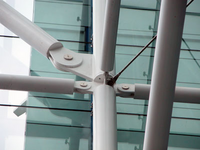duckhawk
Structural
- Jun 3, 2025
- 21
Follow along with the video below to see how to install our site as a web app on your home screen.
Note: This feature may not be available in some browsers.
You called?where is human909? Im curious to see what they would say to OP.
![[tiphat] [tiphat] [tiphat]](/data/assets/smilies/tiphat.gif)
I'm not sure there is much to add, the above responses pretty much have it covered. Yeah this is typically considered a pinned connection but like others have said it will obviously have some moment capacity and attract some moment. (Especially true if axial loads are high.)Im curious to see what they would say to OP.

The difference between the two conditions is that AISC has declared a shear connection between a beam and column as pinned. This position is reinforced by the fact that the bolt holes are larger than the bolts and some rotation is entirely possible. No such declaration that I am aware of has been made for a base connection.Consider a simple shear connection between a beam and column. The beam will have an end moment that is ignored for the most part. That moment will be small if the connection is detailed correctly, such as a double angle with non-thick legs.
Your base plate is kinda like that. If you don't make the plate thick, the moment should be small.
How would you model and design the base plate in the OP's case?The difference between the two conditions is that AISC has declared a shear connection between a beam and column as pinned. This position is reinforced by the fact that the bolt holes are larger than the bolts and some rotation is entirely possible. No such declaration that I am aware of has been made for a base connection.
Some have argued that the base connection will yield before failure which justifies a pin connection, but the analytical model is usually below yield conditions unless one is looking at collapse mechanisms or ASCE 41 criteria in which every connection can become a pinned connection.
In my opinion, those who cite "engineering judgement" without being reinforced by analysis is actually a business decision.
How many legs does a dog have if you call a tail a leg? Four. Just because you call a tail a leg doesn't make it a leg.
If you assumed it was pinned, it will satisfy statics regardless of how much moment the base develops, and the design will be safe. It will develop some moment.For a square moment frame, do you think this is a valid pin boundary condition at the base?
Where does the moment go?
View attachment 14525
But most 'nominally' pinned connections also have the stiffness to behave as a fixed connection. Example this column would likely stand up just fine and remain plump during erection but itself which is an excellent demonstration that both the connection and the footing is fixed and rigid. Likewise I've seen manyThe rotation provided by 1/16 oversize bolt holes is not all that significant and is present in any splice plate moment connection anyway. They are called pins because they have been shown to have the flexibility or ductility to behave as a pin.
But it won't relieve the moment, the moment will remain. It will just be less than the moment of a 100% rigid connection or are more rigidly designed connection. So moment will develop but it will likely be limited by the stiffness of the rest of the structure.The base plate will rotate by bending of the toe and stretching of the bolt, relieving the moment developed. Any moment developed by the base plate will go into the footing. If the footing was not designed as fixed, it will rotate and relieve the moment.
Ground beams to in plane columns quickly fix that. It is no more difficult to achieve that a fixed connection between steel beams. Likewise a deep and broad pile can provide some pretty good stiffness.A fixed base has ZERO rotation, which is diificult to achieve, requiring a thick base plate and a big footing.
